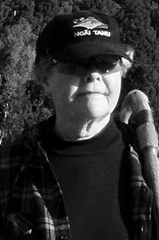He Kōrerorero Dangerous stuff
Jul 18, 2014

 Nā Keri Hulme
Nā Keri Hulme
I once read a story – based on reality – about two brothers who were hoarders. They hoarded all kinds of stuff, including vast numbers of newspapers stacked in teetering towers. One brother was crippled and confined to a wheel chair. The other took care of him. You just know the story didn’t end well…
I’ve been thinking about stuff – material possessions – a lot lately. For the past year plus I’ve been shifting things out of my house at Ōkarito into family homes and paid storage. Despite the fact that several thousand books and quite a bit of furniture has gone from
Big O, the place seems as full as ever.
Since I was a small child, I’ve collected things; books majorly, but also edged weapons and seashells, music (as in 78s and LPs as well as tapes and CDs) and artworks… not paintings or drawings (I enjoy making my own) but furniture and work by skilled wood-turners. Some jewellery, primarily pounamu. And, also since I was a kid, I’ve made survival kits.
I don’t know why. I don’t feel especially threatened by the world in general. I just like to have a preparedness for some possible situations, so I generally have on my person – or carry in a shoulder-bag when I travel – a knife, matches, notebook and pen, tissues, and a torch. At home the knife/knives are a Schrade folder and/or a little black Swiss Army multi-tool; the torches are tiny button numbers attached to my key-rings. Normally, the Schrade stays home, but I discovered I still had it in my pocket when I was on the train headed for Auckland.
It seemed a leetle inadvisable to be packing the thing in a city so I put it in the front pocket of my shoulder-bag.
That shoulder-bag and myself have been travelling – round the world as well as within the shining bright land – for well over two decades. It is ordinary-looking – tough black cloth, with numerous compartments. There’s a couple of external ones, and several internal pockets and – because it’s also a survival kit – there were several pouches attached to it. It only stands out because there is a rather beautiful embroidery of a yellow angelfish glued to the front flap…
Somewhere, somehow, I’ve mislaid it. It may have been at the Aotea Centre in Auckland, where I read, and then signed books for over half an hour. It may have been in a taxi travelling backwards and forwards to the hotel we stayed in (“we” being whānau and self). I don’t know, but it was mislaid on the 18th and it hasn’t turned up yet. And today is the 2nd of June…
There are several things in it – or on it – that are literally irreplaceable. A miniature of my mother, Mary Miller, painted for me by a member of the English Society of Miniaturists. A bone kōauau carved by Brian Flintoff and given to me by Richard Nunns. A unique ring I had made, of pounamu and opal. And a little Olympus camera in a blue and black neoprene case, which contained the last photographs I’ll ever take of my late friend and neighbour, Judith Maloney…
There’s other stuff I’ll miss, but can substitute for – but those things, if lost forever, cannot be – yes, there is an ID on it, in it, but it is not conspicuous. My name and Ōkarito in black felt tip on the inside of my Kai Tahu cap. One of my address stickers inside the Lotto folders.
That is the danger of being attached to stuff. Not only can losing it be painful, but also memories go when the stuff goes out of your reach (well, that’s what happens with me anyway). If that shoulder-bag – and contents – doesn’t get back to me, I will grieve for it for the rest of my life.
I am aware that, with death, we lose all our stuff – and that is inevitable. Other civilisations believed that you can take it with you into a hereafter (the ancient Egyptians are the classic example) but I neither believe in a hereafter or that somehow my property will turn up there…
…but I anchor my memories in the land and in family, on beaches and with trees and in – stuff…
I am thus lessened until that shoulderbag returns, intact, to me…
Writer Keri Hulme is southern Kāi Tahu but lives in “Big O” – Ōkarito. Among her passions are whitebait and family history. In 1985 Keri’s novel The Bone People won the Booker Prize.